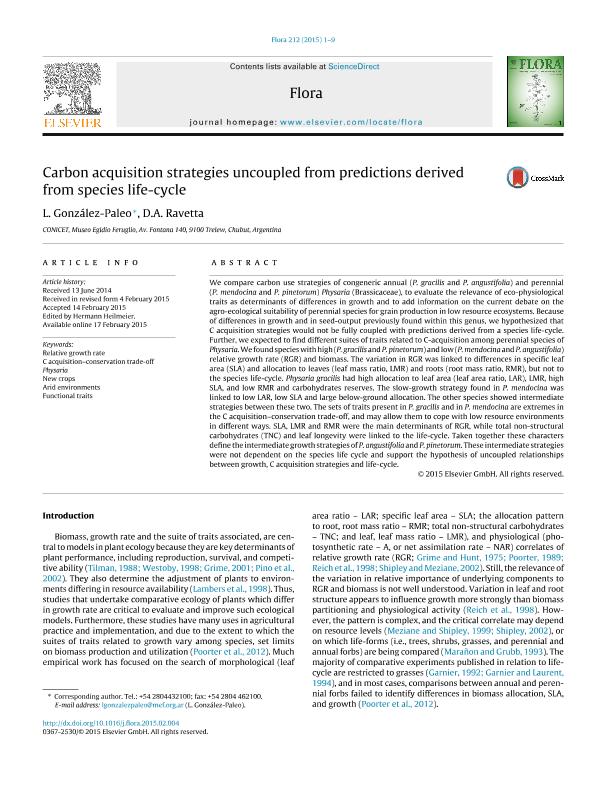Mostrar el registro sencillo del ítem
dc.contributor.author
González Paleo, Luciana

dc.contributor.author
Ravetta, Damián Andrés

dc.date.available
2017-07-18T21:02:11Z
dc.date.issued
2015-03
dc.identifier.citation
González Paleo, Luciana; Ravetta, Damián Andrés; Carbon acquisition strategies uncoupled from predictions derivedfrom species life-cycle; Elsevier Gmbh; Flora; 212; 3-2015; 1-9
dc.identifier.issn
0367-2530
dc.identifier.uri
http://hdl.handle.net/11336/20876
dc.description.abstract
We compare carbon use strategies of congeneric annual (P. gracilis and P. angustifolia) and perennial (P. mendocina and P. pinetorum) Physaria (Brassicaceae), to evaluate the relevance of eco-physiological traits as determinants of differences in growth and to add information on the current debate on the agro-ecological suitability of perennial species for grain production in low resource ecosystems. Because of differences in growth and in seed-output previously found within this genus, we hypothesized that C acquisition strategies would not be fully coupled with predictions derived from a species life-cycle. Further, we expected to find different suites of traits related to C-acquisition among perennial species of Physaria. We found species with high (P. gracilis and P. pinetorum) and low (P. mendocina and P. angustifolia) relative growth rate (RGR) and biomass. The variation in RGR was linked to differences in specific leaf area (SLA) and allocation to leaves (leaf mass ratio, LMR) and roots (root mass ratio, RMR), but not to the species life-cycle. Physaria gracilis had high allocation to leaf area (leaf area ratio, LAR), LMR, high SLA, and low RMR and carbohydrates reserves. The slow-growth strategy found in P. mendocina was linked to low LAR, low SLA and large below-ground allocation. The other species showed intermediate strategies between these two. The sets of traits present in P. gracilis and in P. mendocina are extremes in the C acquisition–conservation trade-off, and may allow them to cope with low resource environments in different ways. SLA, LMR and RMR were the main determinants of RGR, while total non-structural carbohydrates (TNC) and leaf longevity were linked to the life-cycle. Taken together these characters define the intermediate growth strategies of P. angustifolia and P. pinetorum. These intermediate strategies were not dependent on the species life cycle and support the hypothesis of uncoupled relationships between growth, C acquisition strategies and life-cycle.
dc.format
application/pdf
dc.language.iso
eng
dc.publisher
Elsevier Gmbh

dc.rights
info:eu-repo/semantics/openAccess
dc.rights.uri
https://creativecommons.org/licenses/by-nc-sa/2.5/ar/
dc.subject
Relative Growth Rate
dc.subject
C Acquisition-Conservation Trade-Off
dc.subject
Physaria
dc.subject
New Crops
dc.subject
Arid Environments
dc.subject
Functional Traits
dc.subject.classification
Otras Ciencias Agrícolas

dc.subject.classification
Otras Ciencias Agrícolas

dc.subject.classification
CIENCIAS AGRÍCOLAS

dc.title
Carbon acquisition strategies uncoupled from predictions derivedfrom species life-cycle
dc.type
info:eu-repo/semantics/article
dc.type
info:ar-repo/semantics/artículo
dc.type
info:eu-repo/semantics/publishedVersion
dc.date.updated
2017-07-13T14:01:44Z
dc.journal.volume
212
dc.journal.pagination
1-9
dc.journal.pais
Alemania

dc.journal.ciudad
Berlín
dc.description.fil
Fil: González Paleo, Luciana. Museo Paleontológico Egidio Feruglio; Argentina. Consejo Nacional de Investigaciones Científicas y Técnicas; Argentina
dc.description.fil
Fil: Ravetta, Damián Andrés. Museo Paleontológico Egidio Feruglio; Argentina. Consejo Nacional de Investigaciones Científicas y Técnicas; Argentina
dc.journal.title
Flora

dc.relation.alternativeid
info:eu-repo/semantics/altIdentifier/doi/http://dx.doi.org/10.1016/j.flora.2015.02.004
dc.relation.alternativeid
info:eu-repo/semantics/altIdentifier/url/http://www.sciencedirect.com/science/article/pii/S0367253015000109
Archivos asociados
